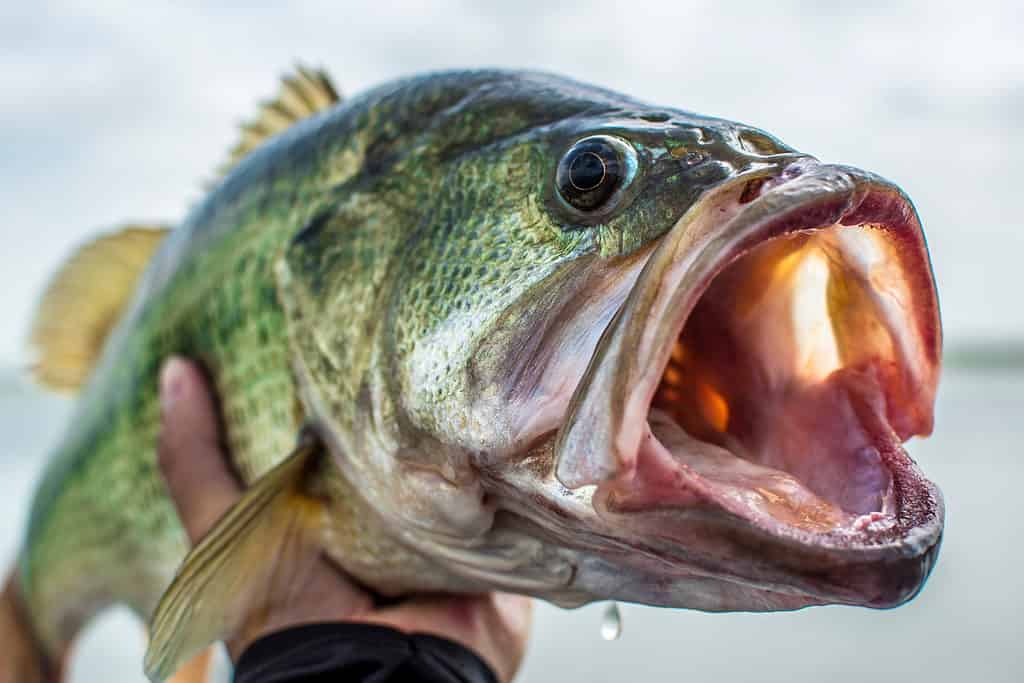South Carolina has some impressive catches. One of the largest fish ever caught in the world was caught in the state! Can you give a wild guess? Follow along to find the largest fish ever caught in South Carolina and more information about other common fish.

South Carolina
has some impressive catches.
©Alex Stemmers/Shutterstock.com
The Largest Fish Ever Caught In South Carolina
While most people don’t think about sharks when you mention fish, the largest fish ever caught in South Carolina was actually a massive tiger shark! In 1964, Walter Maxwell caught an impressive 1,780-pound tiger shark in the Atlantic Ocean, specifically at the Cherry Grove Pier. Not only is this gigantic shark the largest fish in the state but also the largest tiger shark in the world. Currently, it’s tied for the largest tiger shark in the world. In 2004, Kevin James Clapson caught a tiger shark in Australia that weighed only 5 pounds more than Walter Maxwell’s catch. However, the weight difference wasn’t large enough for Clapson’s tiger shark to take over first place.

In 1964, Walter Maxwell caught an impressive 1,780-pound tiger shark in the Atlantic Ocean.
©iStock.com/Divepic
About Tiger Sharks
Tiger sharks are large nocturnal sharks in the family of Galeocerdonidae. They are apex predators and some can grow past 16 feet long. Although tiger sharks have a long history and are old fish, they were only first described in 1822. Its first name was Squalus cuvier, however, in 1837, it was renamed Galeocerdo tigrinus.
Appearance And Size
Tiger sharks are named after their tiger-stripe-like appearance. However, the tiger stripes on their skin fade as they age. Tiger sharks have large mouths and sharp teeth with serrations and sideways-pointing tips. These teeth are tough and sharp enough to cut through sea turtle shells. Tiger sharks are also fast swimmers. With small motions and long fins, they gracefully maneuver through the ocean. Most tiger sharks have light-yellow underbellies and blue to light-green skin. Their skin helps them blend into the water. For example, they are almost invisible to their prey’s invisible eye as they look down for predators. Tiger sharks can detect electric fields with their ampullae of Lorenzini (electroreceptors).
Although tiger sharks are unique-looking fish, they are also known for their impressive size. Some female sharks can grow up to 16 feet long, however, the average tiger shark measures between 10 feet and 8 inches and 13 feet and 11 inches. Female tiger sharks are larger than males. This shark species, on average, weighs between 386 and 1,400 pounds. Although most male tiger sharks stop growing at 12 feet long, the longest recorded male tiger shark was 13 feet and 1 inch. Although unconfirmed, one report found a pregnant 3,360-pound tiger shark.
Diet

Adult tiger sharks hunt for many prey, including dolphin.
©Joost van Uffelen/Shutterstock.com
Tiger sharks are apex predators that eat just about anything. They aren’t picky eaters. These large fish swim close inland to hunt at night but hunt in deeper waters during the day. Young tiger sharks are limited in their diet. They mainly eat jellyfish and small fish. However, when tiger sharks reach 7.5 years old, or sexual maturity, they expand their diets and hunt for larger animals. For example, adult tiger sharks hunt for seals, sea snakes, sea turtles, dolphins, rays, and other smaller sharks. While not as common, tiger sharks also attack and eat wounded or vulnerable whales. Interestingly, in 2006, a group of tiger sharks was recorded killing a humpback whale. Some tiger sharks also eat non-marine animals. In tiger sharks found in Hawaii, researchers recorded dogs, cats, sheep, brown rats, goats, baseballs, license plates, and tires.
Predators

While tiger sharks are apex predators, pods of
killer whales
sometimes prey on them.
©slowmotiongli/Shutterstock.com
While tiger sharks are apex predators, pods of killer whales sometimes prey on them. Although uncommon, when killer whales prey on tiger sharks, they drive it to the surface. When the tiger shark is on the surface, killer whales grab the tiger shark and hold it upside down, essentially drowning them. Afterward, the killer whale bites off the tiger shark’s fins and eats it in the water.
Other Common Fish In South Carolina
Fishing is very popular in South Carolina. Not only can you visit any of the many lakes and rivers in South Carolina, but also fish in the waters surrounding its coast. Regardless of where you go in the state, there’s a chance you’ll catch a fish. Some of the most common fish in the state are listed below.
Largemouth Bass

Largemouth bass
are a favorite for many anglers in South Carolina.
©Pierre Rebollar/Shutterstock.com
Favorite for many anglers in South Carolina, they are very abundant freshwater fish found all throughout the state and the United States. These carnivorous fish was first formally described in 1802. The description was written about a largemouth bass caught near South Carolina’s very own Charleston. Largemouth bass reach impressive lengths and weights. The longest largemouth bass ever recorded was 29.9 inches and about 25 pounds. Interestingly, female largemouth bass are larger than males. Largemouth bass put up a fight, which many anglers enjoy.
Striped Bass

European settlers recorded their surprise and wonder at the abundance of striped bass in the coastal northeast.
©slowmotiongli/Shutterstock.com
Another popular and common fish in South Carolina is the striped bass. These fish have a very similar appearance to largemouth and smallmouth bass, however, they striped bass have longitudinal dark stripes starting from behind the gills and ending at the base of the tail. Striped bass weigh between 20 to 40 pounds. However, the largest striped bass ever caught in the world weighed an impressive 81 pounds and 14 ounces. The largest striped bass recorded was found in a net in 1896 and weighed 124 pounds. Striped bass are found throughout the United States. They are the official state fish of multiple states like Rhode Island and South Carolina. European settlers recorded their surprise and wonder at the abundance of striped bass in the coastal northeast.
Crappie

Crappies are popular game fish for professional and amateur anglers.
©iStock.com/bbevren
There are two species of crappie fish and they are native to North America. Crappies are popular game fish for professional and amateur anglers. The name of this fish comes from the Canadian French crapet, which is a name for multiple sunfish species. Crappies are found in both the U.S. and Canada, including New York, Ontario, Mississippi, Minnesota South Carolina, and Texas. The fun doesn’t end during winter. Crappies are active in the winter, which entices many ice anglers. You can ice fish for crappie. These fish are also one of the best-tasting freshwater food fish.
Brook Trout

Brook trouts are adaptable, they prefer clear, cool, and well-oxygenated water.
©M Rose/Shutterstock.com
They are freshwater fish native to South Carolina that live about 4 to 5 years in the wild. Brook trouts mainly live in the mountain streams of Oconee. The average length of a brook trout is 4 to 7 inches and they weigh about 1 to 3 ounces. However, the largest brook trout caught in South Carolina weighed 4 pounds and 10 ounces. While brook trouts are adaptable, they prefer clear, cool, and well-oxygenated water. Brook trout feast on small insects, fish, salamanders, and frogs.
Blue Catfish

Blue
catfish
have deeply forked tail fins and blue-grey shimmering skin.
©Billy Ogle/Flickr – License
The largest caught in South Carolina weighed a little over 113 pounds! The average length of a blue catfish is 20 to 45 inches and on average they weigh anywhere between 3 and 40 pounds. They have deeply forked tail fins and blue-grey shimmering skin. This fish species is commonly found in South Carolina’s public fishing lakes and nearly all drainages. Blue catfish are native to the Mississippi River basin. Although the average weight of a blue catfish is lower now, in the 1800s, blue catfish as heavy as 300 pounds were recorded in Missouri. Although not native to South Carolina, they were introduced in 1964.
Where Is South Carolina On A Map?
South Carolina is located in the southeastern region of the United States. It is bordered by the Atlantic Ocean on the east, Georgia to the south, and North Carolina to the east. The Cherry Grove Pier is in the North Myrtle Beach Area, which is in Horry County and located near the North Carolina/South Carolina border.
The photo featured at the top of this post is © Michael Rothschild/Shutterstock.com
Thank you for reading! Have some feedback for us? Contact the AZ Animals editorial team.






